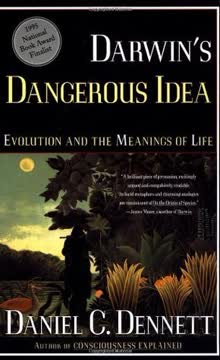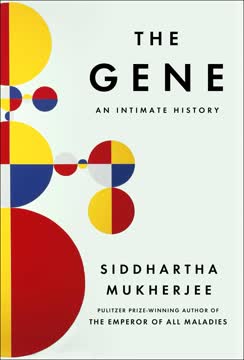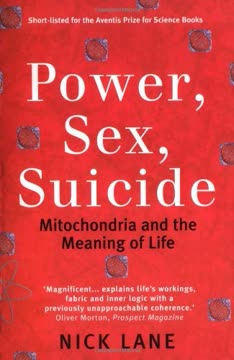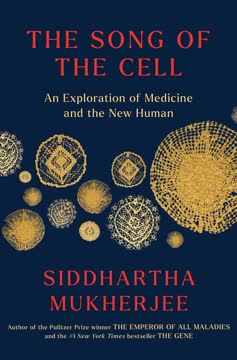Key Takeaways
1. Mūsu genomā ir dzīves grāmata, rakstīta digitālā kodā
Cilvēka genoms ir grāmata ... Tajā ir divdesmit trīs nodaļas, ko sauc par HROMOSOMĀM. Katrs nodaļas satur vairākus tūkstošus stāstu, ko sauc par GĒNIEM.
Digitālā dzīves valoda. Genoms ir pamatā informācijas sistēma, kas kodēta četrvēstu alfabētā DNS (A, C, G, T). Šis digitālais kods satur instrukcijas cilvēka būvēšanai un darbībai. Genoma struktūra atgādina grāmatu:
- 23 hromosomas ("nodaļas")
- 20,000-25,000 gēnu ("stāsti")
- 3 miljardi DNS bāzu pāru ("burti")
Tāpat kā datoru kodu, genomu var lasīt, kopēt un pat rediģēt. Šī digitālā daba ļauj precīzi replicēt un nodot ģenētisko informāciju pa paaudzēm.
2. Mums ir kopīgs priekštecis ar visām dzīvajām būtnēm
Mušas un cilvēki ir tikai variācijas par tēmu, kā uzbūvēt ķermeni, kas tika noteikts kādā tārpu līdzīgā radībā Kambrija periodā.
Dzīves vienotība. Visa dzīve uz Zemes dalās kopīgā priekštecī un izmanto to pašu ģenētisko kodu. Tas izskaidro, kāpēc:
- Daudzi gēni ir saglabājušies plaši atšķirīgās sugās
- Mēs varam pētīt augļu mušas vai peles, lai uzzinātu par cilvēka bioloģiju
- Ģenētiskā inženierija var pārvietot gēnus starp sugām
Līdzības ģenētiskajos mehānismos starp dzīvajām formām sniedz pārliecinošus pierādījumus evolūcijai un mūsu dziļajai saiknei ar visām dzīvajām būtnēm.
3. Gēni nav tikai slimībām, bet veido mūsu visu bioloģiju
GĒNI NAV TUR, LAI IZRAISĪTU SLIMĪBAS.
Gēni kā instrukcijas. Lai gan mēs bieži koncentrējamies uz slimības izraisošām mutācijām, gēni galvenokārt kodē instrukcijas normālām bioloģiskām funkcijām:
- Mūsu ķermeņu būvēšana un uzturēšana
- Fizioloģisko procesu regulēšana
- Uzvedības un kognitīvo īpašību ietekmēšana
Gēni, kas saistīti ar slimībām, parasti pārstāv normālo gēnu variantus, kuriem ir būtiskas funkcijas. Šo normālo funkciju izpratne ir būtiska bioloģijas un medicīnas attīstībai.
4. Daba un audzināšana mijiedarbojas sarežģītā veidā, lai ietekmētu mūsu īpašības
Tālu no tā, ka mēs esam mūsu visvareno gēnu žēlastībā, bieži vien mūsu gēni ir tie, kas ir mūsu žēlastībā.
Gēnu un vides mijiedarbība. Mūsu īpašības ir rezultāts sarežģītām mijiedarbībām starp mūsu gēniem un vidi:
- Gēni var ietekmēt, kā mēs reaģējam uz vides faktoriem
- Vides faktori var ietekmēt gēnu ekspresiju
- Daži gēni ietekmē mūsu tieksmi meklēt noteiktas vides
Šī mijiedarbība nozīmē, ka ne gēni, ne vide vieni paši nosaka mūsu likteni. Šo mijiedarbību izpratne ir atslēga, lai atklātu cilvēka bioloģijas un uzvedības sarežģījumus.
5. Cilvēka genoms satur mūsu evolūcijas pagātnes paliekas
Mēs esam pilni digitālo ķēdes vēstuļu un brīdinājumu par marmelādi.
Genoma fosilijas. Mūsu genoms ir vēsturisks dokuments, kas satur:
- Senču vīrusu paliekas
- Dublētus gēnus
- "Pašsajūtas" DNS elementus, kas replicē sevi
Šīs genoma fosilijas sniedz ieskatu mūsu evolūcijas vēsturē un genomu dinamiskajā dabu. Tās arī izceļ, ka ne visa DNS ir pašreizējai funkcionālai nozīmei.
6. Ģenētiskā zināšana nes gan solījumus, gan ētiskas problēmas
Nav brīnums, ka Amerikā veselības apdrošināšanas kompānijas jau izrāda interesi par ģenētiskajiem testiem Alcheimera slimībai, kas var būt ļoti dārga viņiem.
Divas asmeņu zobens. Ģenētiskās zināšanas attīstība piedāvā lielu potenciālu medicīnā, bet arī rada ētiskas bažas:
- Potenciāls personalizētai medicīnai un slimību profilaksei
- Ģenētiskās diskriminācijas risks apdrošināšanā vai nodarbinātībā
- Ētiskas dilemmas reproduktīvajās izvēlēs un ģenētiskajā inženierijā
Līdzsvarot ģenētiskās zināšanas ieguvumus ar ētiskajām apsvērumiem ir būtisks izaicinājums sabiedrībai.
7. Brīvā griba pastāv mūsu ģenētiskā determinisma ierobežojumos
Brīvība slēpjas savas determinismu izpausmē, nevis kāda cita.
Determinisma un brīvās gribas izlīdzināšana. Lai gan mūsu gēni ietekmē mūsu īpašības un tendences, tie nenosaka stingri mūsu izvēles:
- Gēni rada tieksmes, nevis fiksētas likteņus
- Mūsu apzinātās izvēles var pārspēt ģenētiskās ietekmes
- Izpratne par mūsu ģenētiskajām predispozīcijām var dot mums iespēju pieņemt informētus lēmumus
Šī perspektīva ļauj mums pieņemt gan ģenētisko ietekmju realitāti, gan personiskās atbildības un izvēles nozīmi.
Last updated:
FAQ
What's Genome: The Autobiography of a Species in 23 Chapters about?
- Exploration of the genome: The book delves into the human genome, explaining how genes influence various aspects of human biology and behavior.
- Chromosome-by-chromosome narrative: Matt Ridley examines each chromosome, linking them to themes of human nature and history, providing a comprehensive view of genetics.
- Interdisciplinary insights: It combines genetics, anthropology, psychology, and philosophy to show how our genetic makeup shapes who we are.
Why should I read Genome: The Autobiography of a Species in 23 Chapters?
- Understanding genetics' impact: The book helps readers grasp how genetics influences health, behavior, and identity, essential for understanding ourselves.
- Engaging storytelling: Ridley’s narrative style makes complex scientific concepts accessible and engaging, using anecdotes and historical context.
- Timely relevance: It addresses contemporary issues in genetics, such as genetic engineering and ethical implications, making it a thought-provoking read.
What are the key takeaways of Genome: The Autobiography of a Species in 23 Chapters?
- Genes shape our lives: Genes play a crucial role in determining health, personality, and behavior, illustrated through examples from different chromosomes.
- Complexity of inheritance: Traits are influenced by multiple genes and environmental factors, challenging simplistic notions of genetic determinism.
- Interconnectedness of life: The book underscores that all life is interconnected through shared genetic codes, emphasizing common ancestry.
What are the best quotes from Genome: The Autobiography of a Species in 23 Chapters and what do they mean?
- “We are living through the greatest intellectual moment in history.”: Reflects the transformative power of genetic knowledge, revolutionizing fields like medicine.
- “The genome is a book that wrote itself.”: Illustrates the dynamic nature of the genome, evolving over time through mutations and natural selection.
- “Life consists of the interplay of two kinds of chemicals: proteins and DNA.”: Highlights the fundamental relationship between genes and proteins in biological processes.
How does Genome: The Autobiography of a Species in 23 Chapters explain the relationship between genes and diseases?
- Genes as disease contributors: Certain genes can predispose individuals to specific diseases, crucial for developing effective treatments.
- Complexity of genetic diseases: Many diseases are influenced by multiple genes and environmental factors, requiring a nuanced understanding.
- Role of genetic research: Continued research into the human genome is advocated to uncover the genetic basis of diseases for better prevention and treatment.
What is the significance of chromosome 2 in Genome: The Autobiography of a Species in 23 Chapters?
- Fusion of ape chromosomes: Chromosome 2 is formed from the fusion of two ape chromosomes, highlighting evolutionary relationships.
- Implications for human evolution: This fusion suggests a significant evolutionary event contributing to modern human development.
- Understanding human uniqueness: Examining chromosome 2 explores genetic traits distinguishing humans from other primates.
How does Genome: The Autobiography of a Species in 23 Chapters address the concept of free will?
- Genetic influence on behavior: Genes can shape behaviors and personality traits, raising questions about the extent of free will.
- Interplay of nature and nurture: Both genetic and environmental factors shape behavior, essential for understanding free will.
- Philosophical implications: Genetic knowledge can inform our understanding of human agency, leading to greater self-awareness.
What role do environmental factors play in Genome: The Autobiography of a Species in 23 Chapters?
- Interaction with genetics: Environmental factors interact with genetic predispositions to shape traits and health outcomes.
- Examples of environmental influence: Lifestyle choices can impact gene expression and health, highlighting the importance of both genetics and environment.
- Dynamic nature of the genome: The genome can be influenced by environmental factors throughout life, underscoring genetic inheritance complexity.
How does Genome: The Autobiography of a Species in 23 Chapters explain the concept of eugenics?
- Historical context: The history of eugenics and its association with genetic determinism is discussed, highlighting dangers of misapplying genetic knowledge.
- Modern implications: Warns against potential misuse of genetic information, advocating for ethical considerations in genetic research.
- Call for responsible science: Emphasizes the need for responsible scientific inquiry that respects individual rights and diversity.
What insights does Genome: The Autobiography of a Species in 23 Chapters provide about human history?
- Genetic record of migration: The human genome contains clues about ancestors’ migrations and adaptations, revealing patterns of human history.
- Connection to ancient diseases: Historical diseases have shaped genetic makeup, influencing traits like resistance to infections.
- Interconnectedness of all life: The genome serves as a record of shared ancestry, fostering appreciation for biodiversity and conservation.
What is the significance of Hox genes in Genome: The Autobiography of a Species in 23 Chapters?
- Role in body plan: Hox genes determine the layout of an organism's body during embryonic development.
- Conservation across species: Remarkably similar in different species, indicating a common evolutionary ancestor.
- Implications for understanding evolution: Provides insights into how complex body structures evolved, revealing genetic diversity basis.
How does Genome: The Autobiography of a Species in 23 Chapters relate to the future of genetic research?
- Promise of personalized medicine: Genetic research could lead to personalized medical treatments tailored to individual genetic profiles.
- Ethical considerations: Raises important ethical questions about genetic engineering and implications of manipulating the human genome.
- Ongoing discoveries: The field of genetics is rapidly evolving, with new discoveries continually reshaping our understanding of biology.
Review Summary
Genoms: Suģestējošs stāsts par sugu 23 nodaļās saņēma galvenokārt pozitīvas atsauksmes par tā pieejamo ģenētikas skaidrojumu un aizraujošo rakstīšanas stilu. Lasītāji novērtēja Ridleja pieeju, izmantojot katru hromosomu, lai izpētītu dažādus cilvēka bioloģijas un sabiedrības aspektus. Daži uzskatīja, ka daļas ir novecojušas vai kritizēja Ridleja personīgās domas, taču daudzi joprojām ieteica to kā informatīvu ievadu ģenētikā. Grāmatas izpēte par pretrunīgiem tematiem, piemēram, intelektu un eugeniku, izraisīja diskusijas starp lasītājiem.
Similar Books




















